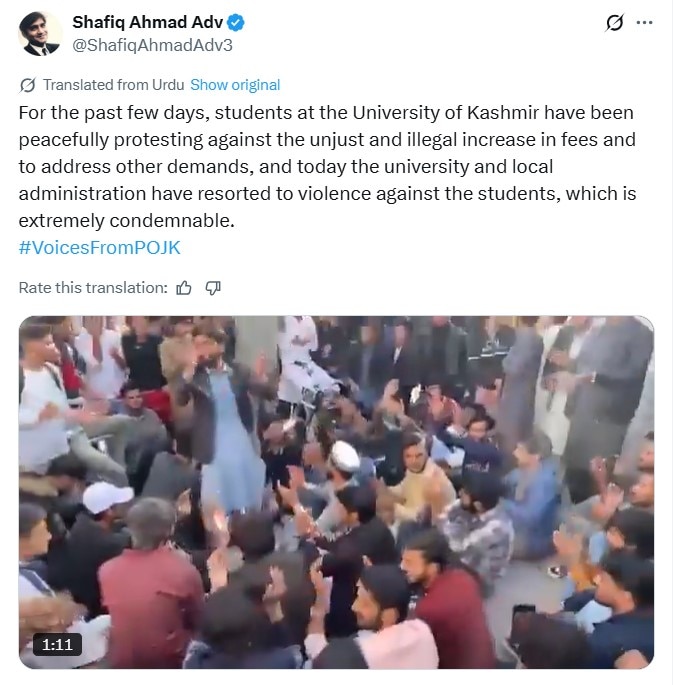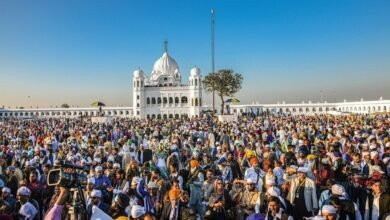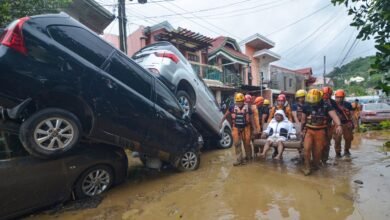Pakistan POK protests: Gen Z protests see violence in Pakistan Occupied Kashmir

Pakistan POK protests: Gen Z protests see violence in Pakistan Occupied Kashmir
Weeks after Pakistan-Occupied Kashmir (POK) was rocked by a violent unrest, another wave of protests has gripped the region – this time being led by the Gen Z, mostly students, over educational reforms. However, what began as a peaceful demonstration against rising fees and the evaluation process has snowballed into protests against the Shehbaz Sharif-led government, exposing the deepening discontent among Gen Z in the restive region.
While the protests, which erupted earlier this month, were mostly peaceful, it reportedly descended into chaos after an unidentified gunman opened fire on a group of students, injuring one. Viral videos on social media show a man opening fire on protesters in Muzaffarabad, triggering panic in the area. Reports said the incident happened in the presence of police officers. India Today could not verify the authenticity of the video.

POK GENZ PROTESTS TURN VIOLENT
It marked a turning point in the agitation, as infuriated students burnt tyres, resorted to arson and vandalism, and chanted slogans against the Pakistan government – mirroring the Gen Z protests in South Asian nations of Nepal and Bangladesh.
The protests began at one of the top universities in Muzaffarabad over rising fees and a demand for better facilities. As the agitation gained momentum, the administration immediately banned political activities at the university.
A similar agitation had broken out in January 2024. The students had alleged that lakhs of rupees were being collected every 3 or 4 months in the name of semester fees. Then, teaching and administrative staff in POK also joined the protests, demanding their long-overdue salary increases.
WHAT ARE THE DEMANDS
This time, intermediate students have joined the protests. Their grouse is the introduction of a new e-marking or digital assessment system at the matriculation and intermediate levels in the new academic year.
On October 30, the results of the intermediate first-year exams were announced in POK after a six-month delay. However, it triggered outrage as students complained of being given unexpectedly low marks, which they attributed to the e-marking system, local reports said.
In some cases, students were passed in subjects whose exams they had not even attended. While there has been no clarification from the government, the education board in Mirpur has formed a committee to assess the e-marking process.
The protesters have also demanded a waiver of the rechecking fees, which have been set at a hefty Rs 1,500 per subject paper. Thus, students who want papers of all their seven subjects rechecked will need to shell out Rs 10,500.
The issue has also reverberated in Pakistani cities like Lahore, where intermediate students staged a sit-in last month outside the Lahore Press Club.
However, the list of grievances of the students has now gone far beyond the classroom – crumbling infrastructure, poor healthcare, and lack of transportation have added to the frustration of the youth.
What has given weight to the agitation is the backing of the influential Joint Awami Action Committee (JAAC), which was at the forefront of the violent protests in October.
UNREST GRIPPED POK A MONTH AGO
Over 12 civilians died in the unrest, which began over a charter of 30 demands that included tax relief, subsidies on flour and electricity, and completion of development projects.
However, as the Pakistani government attempted to crack down on the agitation by opening fire, it spiralled into a broader agitation against excesses by the military under army chief Asim Munir and corruption, bringing the region to a standstill.
The unrest eventually ended after the Sharif government blinked and signed an agreement with the protesters, agreeing to some of their key demands.
SIMILAR UPRISING IN NEPAL
The latest flare-up is different. It is the Gen Z who have now taken the lead, while the protests last month were by the political class and activists.
The timing is crucial, coming weeks after neighbouring Nepal witnessed a youth-led uprising that led to the fall of the KP Sharma Oli-led government. In Nepal too, what started as a protest against a social media ban snowballed into a wider agitation against deep-seated corruption.
Such was the level of anger among the Gen Z that not only were houses of almost all ministers ransacked and set on fire, but even the Parliament was gutted.
A similar pattern played out in Bangladesh in 2024, leading to the collapse of the Sheikh Hasina government, and in Sri Lanka in 2022, where public fury over domestic issues quickly mushroomed into anti-corruption protests.
It remains to be seen how the unrest in POK plays out in the coming days, adding to the growing resentment against the Sharif-Munir duo.
– Ends
Source link



